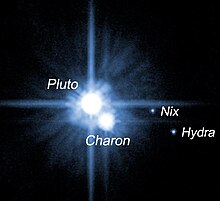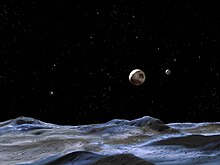Plutonen sateliteak

Pluton planeta nanoaren sisteman sei gorputz ezagutzen dira, planeta nanoa kontuan hartuta. Normalean gorputz hauek Plutonen satelite bezala ezagutzen ditugun arren, berez, Pluton eta Karontek osatutako sistema bitar baten mendeko dira. Karontek ordea, Plutonek baino askoz ere masa txikiagoa du, zehazki, planeta nanoaren %11,65a. Hala ere, satelite hau eguzki-sistemako sateliterik handiena da beraien ama-planetarekin alderatzen baditugu, hau da, beste satelite guztiak mendeko diren planeta baino askoz ere txikiagoak dira.

Pluton eta Karontez gain, beste lau satelite gehiagok orbitatzen dute Pluton. Hauetatik garrantzitsuenak 2005ean aurkitu ziren Nix (behin-behineko izena: S/2005 P 1) eta Hidra (S/2005 P 2) dira. Beste bi sateliteak beranduago aurkitu ziren, txikiagoak direlako. Beraien izenak Kerberos eta Styx dira.
Plutonen sateliteen datuak
[aldatu | aldatu iturburu kodea]
| Izena | Diametroa (km) | Masa (kg) | Orbita (egunak) | Aurkitzailea | Urtea |
|---|---|---|---|---|---|
| Karonte | 1207 ± 3 | (1,52±0,06)×1021 | 6,387230 | J. W. Christy | 1978 |
| Nix | 46 - 137 | 5×1016 - 2×1018 | 24,856 | Hubble | 2005 |
| Hidra | 61 - 167 | 5×1016 - 2×1018 | 38,206 | Hubble | 2005 |
| Kerberos | 13-34 | ? | 31 | Hubble | 2011 |
| Styx | 10-25 | ? | ? | Hubble | 2012 |
Sorrera
[aldatu | aldatu iturburu kodea]Hipotesi onartuenak dioenez, Plutonen sateliteak talka handi baten eraginez sortu ziren, Lur planetan Ilargia sortu zuela pentsatzen den talka baten antzekoak. Honek esan nahi du, planetak ez zituela gorputzak Kuiper gerrikotik harrapatu, askotan pentsatu izan denaren kontrara.
Iruditegia
[aldatu | aldatu iturburu kodea]-
Pluton eta Karonte eskalan. 2015eko uztailaren 8an New Horizonsek ateratako argazkia.
-
Plutonen sistema: Karonte, Hidra, Nix, Kerberos eta Styx. 2012ko uztailean Hubblek ateratako argazkia.
-
Plutonen hiru sateliteak, eskalan.
-
Plutonen sistemako gorputzen tamaina, gutxi gorabehera.
-
Karonte, Plutonen satelitea. New Horizons zundak 2015eko uztailaren 13an atera zion argazkia.
Ikus, gainera
[aldatu | aldatu iturburu kodea]- Pluton eta haren geologia
- Jupiterren sateliteak
- Saturno, Urano eta Neptunoren sateliteak
- Eguzki-sistema
Kanpo estekak
[aldatu | aldatu iturburu kodea]
| |||||||||||||||||||||||
| Zerrendak | |||||||||||||||||||||||
| Hipotetikoak |
| ||||||||||||||||||||||
Ikus, gainera: Eguzki-sistemaren sorrera eta garapena eta Eguzki sistemaren ataria | |||||||||||||||||||||||
Text is available under the CC BY-SA 4.0 license; additional terms may apply.
Images, videos and audio are available under their respective licenses.






